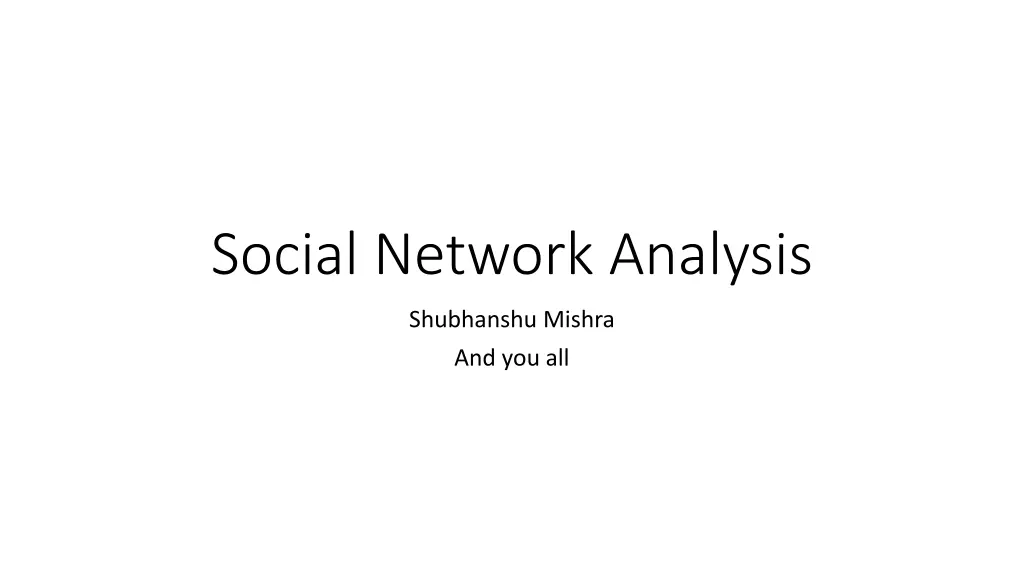
Understanding Social Network Analysis for Identifying Important People and Communities
Dive into the world of social network analysis with this comprehensive guide. Learn how to identify key individuals, explore various interactions, and discover how networks are formed. Be prepared to make sense of complex social structures by the end of the course.
Download Presentation

Please find below an Image/Link to download the presentation.
The content on the website is provided AS IS for your information and personal use only. It may not be sold, licensed, or shared on other websites without obtaining consent from the author. If you encounter any issues during the download, it is possible that the publisher has removed the file from their server.
You are allowed to download the files provided on this website for personal or commercial use, subject to the condition that they are used lawfully. All files are the property of their respective owners.
The content on the website is provided AS IS for your information and personal use only. It may not be sold, licensed, or shared on other websites without obtaining consent from the author.
E N D
Presentation Transcript
Social Network Analysis Shubhanshu Mishra And you all
Learning objectives What is a (social) network? How to create one? Important questions which can be answered using social network analysis: Identifying important people Finding communities How do these networks form?
By the end of the course you will be able to make sense of this figure.
What is a Network?
Nodes Actors Entities
Edges Connections Relations
What is a Social Social Network? Nodes are individuals (people) Edges are some kind of interaction or relationship between people
What are examples of social networks around us?
Source: https://www.facebook.com/notes/facebook-security/facebook-invites-submissions-for-secure-the-internet-grants/10155036231140766/
1st Grade Who Shall Survive: A New Approach to the Problem of Human Interrelations J. L. Moreno (1934) Source: http://www.martingrandjean.ch/social-network-analysis-visualization-morenos-sociograms-revisited/
2nd Grade Source: http://www.martingrandjean.ch/social-network-analysis-visualization-morenos-sociograms-revisited/
6th Grade Source: http://www.martingrandjean.ch/social-network-analysis-visualization-morenos-sociograms-revisited/
What is analysis? Finding patterns in data Answering questions based on data
What questions can be answered by Social Network Analysis? Social Network Analysis?
Which nodes are important? Which nodes are important? (centrality measures) (centrality measures) Who is connected to most people? - Degree centrality Who is acting as a most popular bridge of information in the network? Betweenness centrality Who is closest to everyone else in the network? Closeness centrality Who is connected to the most important people (recursive definition)? Eigenvector centrality (also known as PageRank)
Where do you see PageRank centrality?
What are communities in the network? Many ways of identifying communities One popular way is connections within community should be more than connections across communities Demo using Gephi
How do these networks form? Many explanations
Random linking between nodes Also called Random graph model Gives rise to a large connected network # of connections of each node are normally distributed Demo: http://www.netlogoweb.org/launch#http://www.netlogoweb.org/assets/modelslib/Sample%20Models/Networks/Giant%20Component.nlogo
New people more likely to link to popular people Also called Preferential attachment models Few people have majority of the connections in the network These people act as hubs of information Demo: http://www.netlogoweb.org/launch#http://www.netlogoweb.org/assets/modelslib/Sample%20Models/Networks/Preferential%20Attachment.nlogo
Most links between neighbors but some links to farther people Also called Small world phenomenon Small average distance between people High percentage of friends of a person know each other Demo: http://www.netlogoweb.org/launch#http://www.netlogoweb.org/assets/modelslib/Sample%20Models/Networks/Small%20Worlds.nlogo
What we learnt? Network nodes and edges Social network nodes = people, edges = social connections Examples: Facebook, school networks Answering questions using social networks Identifying important people many measures of importance How to find communities in networks How do these networks form Using Gephi for network analysis and NetLogo for network simulation
Questions Shubhanshu Mishra http://shubhanshu.com/ https://twitter.com/TheShubhanshu






















